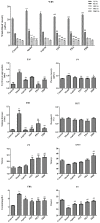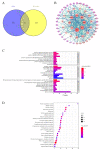Integrating UPLC-Q-TOF-MS and Network Pharmacology to Explore the Potential Mechanisms of Paeonia lactiflora Pall. in the Treatment of Blood Stasis Syndrome
- PMID: 38998977
- PMCID: PMC11243510
- DOI: 10.3390/molecules29133019
Integrating UPLC-Q-TOF-MS and Network Pharmacology to Explore the Potential Mechanisms of Paeonia lactiflora Pall. in the Treatment of Blood Stasis Syndrome
Abstract
Paeonia lactiflora Pall. (PLP) is thought to promote blood circulation and remove blood stasis. This study used blood component analysis, network pharmacology, and molecular docking to predict the mechanism of PLP in the treatment of blood stasis syndrome (BSS). PLP was processed into Paeoniae Radix Alba (PRA) and Paeoniae Radix Rubra (PRR). PRA and PRR could significantly reduce whole blood viscosity (WBV) at 1/s shear rates and could increase the erythrocyte aggregation index (EAI), plasma viscosity (PV), and erythrocyte sedimentation rate (ESR) of rats with acute blood stasis. They prolonged the prothrombin time (PT), and PRR prolonged the activated partial thromboplastin time (APTT). PRA and PRR increased the thrombin time (TT) and decreased the fibrinogen (FBG) content. All the results were significant (p < 0.05). Ten components of Paeoniflorin, Albiflorin, Paeonin C, and others were identified in the plasma of rats using ultra-high-performance liquid chromatography-quadrupole time-of-flight mass spectrometry (UPLC-Q-TOF-MS). A protein-protein interaction network (PPI) analysis showed that AKT1, EGFR, SRC, MAPK14, NOS3, and KDR were key targets of PLP in the treatment of BSS, and the molecular docking results further verified this. This study indicated that PLP improves BSS in multiple ways and that the potential pharmacological mechanisms may be related to angiogenesis, vasoconstriction and relaxation, coagulation, and the migration and proliferation of vascular cells.
Keywords: Paeonia lactiflora Pall; UPLC-Q-TOF-MS; blood stasis syndrome; molecular docking; network pharmacology.
Conflict of interest statement
The author Dezhu Ge was employed by Anhui Jiren Pharmaceutical Co., Ltd. The remaining authors declare that the research was conducted in the absence of any commercial or financial relationships that could be construed as potential conflicts of interest.
Figures








Similar articles
-
Untargeted Metabolomics Based on UPLC-Q-Exactive-Orbitrap-MS/MS Revealed the Differences and Correlations between Different Parts of the Root of Paeonia lactiflora Pall.Molecules. 2024 Feb 24;29(5):992. doi: 10.3390/molecules29050992. Molecules. 2024. PMID: 38474505 Free PMC article.
-
An integrated serum pharmacochemistry, network pharmacology, and metabolomics strategy: A study on raw and wine-processed Paeoniae Radix Alba in promoting blood circulation to alleviate blood stasis.Fitoterapia. 2025 Apr;182:106449. doi: 10.1016/j.fitote.2025.106449. Epub 2025 Feb 21. Fitoterapia. 2025. PMID: 39988208
-
[Mechanism of Bupleurum scorzonerifolium and Paeonia lactiflora herbal pair against liver cancer: an exploration based on UPLC-Q-TOF-MS combined with network pharmacology].Zhongguo Zhong Yao Za Zhi. 2022 Jul;47(13):3597-3608. doi: 10.19540/j.cnki.cjcmm.20220110.402. Zhongguo Zhong Yao Za Zhi. 2022. PMID: 35850814 Chinese.
-
Total glucosides of paeony: A review of its phytochemistry, role in autoimmune diseases, and mechanisms of action.J Ethnopharmacol. 2020 Aug 10;258:112913. doi: 10.1016/j.jep.2020.112913. Epub 2020 May 1. J Ethnopharmacol. 2020. PMID: 32371143 Review.
-
Paeoniae Radix Rubra: A Review of Ethnopharmacology, Phytochemistry, Pharmacological Activities, Therapeutic Mechanism for Blood Stasis Syndrome, and Quality Control.Chem Biodivers. 2024 Aug;21(8):e202401119. doi: 10.1002/cbdv.202401119. Epub 2024 Jul 23. Chem Biodivers. 2024. PMID: 38850115 Review.
Cited by
-
Paeoniflorin Attenuates Limb Ischemia by Promoting Angiogenesis Through ERα/ROCK-2 Pathway.Pharmaceuticals (Basel). 2025 Feb 19;18(2):272. doi: 10.3390/ph18020272. Pharmaceuticals (Basel). 2025. PMID: 40006085 Free PMC article.
-
Nontargeted Metabolomic Profiling of a Single Paeonia Lactiflora Plant and its Quality Marker Identification.ChemistryOpen. 2025 Aug;14(8):e202400520. doi: 10.1002/open.202400520. Epub 2025 May 24. ChemistryOpen. 2025. PMID: 40411852 Free PMC article.
References
-
- Chinese Pharmacopoeia Commission . Pharmacopoeia of the People’s Republic of China. China Medical Science Press; Beijing, China: 2020. pp. 108–165.
MeSH terms
Substances
LinkOut - more resources
Full Text Sources
Research Materials
Miscellaneous

